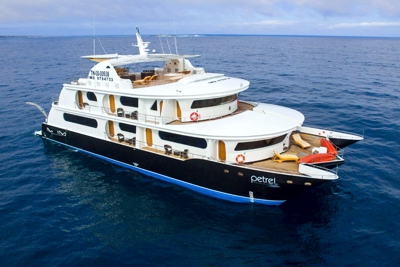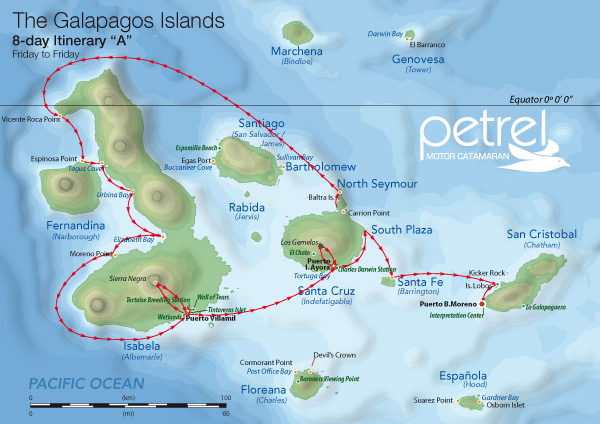

Destinations
Experiences
 |
L A
D A T C O T O U R
S |
 |
||||||||
| HOME | South America | Falkland Islands | Antarctica | Unique Destinations |
Unique Experiences |
Newsstand | ||||
 |
GALAPAGOS ISLANDS
Petrel
|
 |
||||||
|
Itinerary "A" |

Day 1 (Friday)
FROM QUITO OR GUAYAQUIL TO BALTRA
Assistance will be provided for you when you arrive to the airport by one of our representatives after you have landed.AM. Baltra Island
You will arrive at Baltra Island in the morning. After passing through immigration and baggage claim you will be met by Petrel staff and transferred to the yacht. You will be shown to your cabin where you will have some time to settle in before lunch and a welcome briefing.PM. North Seymour Island
Galapagos Sea Lions, Blue-footed Boobies and Magnificent Frigatebirds are abundant on North Seymour Island. The island was formed by a series of submarine lavas containing layers of sediment that were uplifted by tectonic activity. The island is characterized by its arid vegetation zone.
|
Highlights: |
Land & marine iguanas, frigatebirds, Blue-footed Boobies, sea lions; snorkeling: Rays, reef shark, fish, garden eels. |
|
Possible Activities: |
Snorkeling, dinghy ride & hiking (1.5 mi/2.5 km) |
|
Type of Landing: |
Dry landing |
|
Difficulty: |
Moderate / Difficult |
Day 2 (Saturday)
AM. Vicente Roca Point (Isabela Island)
The largest in the archipelago, this seahorse-shaped island is also one of the youngest and most volcanically active. The morning visit is to Vicente Roca Point. Comprised of two separate coves, this site is a large bay with spectacular sea life. Keep an eye out for seahorses, sea turtles, and the strange yet fascinating Mola-mola.
|
Highlights: |
Penguins, Blue-footed Boobies, terns, Nazca Boobies, two types of sea lions. Snorkeling: sea turtles, rays and puffer fish. |
|
Possible Activities: |
Snorkeling & panga ride |
|
Type of Landing: |
No landing |
|
Difficulty: |
Easy / Moderate |
PM. Espinosa Point (Fernandina Island)
Crossing the Bolivar Channel that divides Isabela and Fernandina Islands, we will land at Espinosa Point. After walking past a colony of marine iguanas and a group of sea lions, we'll reach the island's highlight: the Flightless cormorant nesting site. This area also provides a great opportunity to see the Galapagos Hawk.
|
Highlights: |
Flightless Cormorant, marine iguanas, A'A lava, sea lions, penguins, active volcano “La Cumbre” |
|
Possible Activities: |
Hike (1.2 mi/2 km) |
|
Type of Landing: |
Dry and slippery at low tide |
|
Difficulty: |
Moderate |
Day 3 (Sunday)
AM. Tagus Cove (Isabela Island)
Tagus Cove is located across from Fernandina Island, near the Bolivar Channel dividing the two islands. This spot has been frequented by ships since the 1800s, using the area as an anchorage site. Trails winding by Lake Darwin up to a ridge display wonderful views. Punta Tortuga, just north of Tagus Cove, is another lovely beach surrounded by mangroves.
|
Highlights: |
Penguins, Flightless Cormorants, Darwin Volcano & Lake |
|
Possible Activities: |
Long hike, snorkeling, dinghy ride |
|
Type of Landing: |
Dry landing |
|
Difficulty: |
Moderate / Difficult |
PM. Urbina Bay (Isabela Island)
Urbina Bay is located at the base of Alcedo Volcano on the west coast, between Tagus Cove and Elizabeth Bay. This area experienced a major uplift in 1954, causing the land to rise over 16 feet. The coast expanded half a mile out, leaving marine life stranded on the new shore. This area is also a great place for snorkeling.
|
Highlights: |
Land iguanas (the biggest in Galapagos), hawks, coral reef, giant tortoises; snorkeling: turtles, rays, tropical fish |
|
Possible Activities: |
Snorkeling, dinghy ride & hike, 2 trails: short (0.6mi/1 km), long (1.9mi/3km) |
|
Type of Landing: |
Wet landing |
|
Difficulty: |
Easy / Moderate |
Day 4 (Monday)
AM. Elizabeth Bay (Isabela Island)
Elizabeth Bay is located on the east coast of Isabela Island. The bay contains many islets, which can be visited by dinghy. Penguins and Blue-footed Boobies can be spotted on the rocky islets. With an abundance of marine life and clear water, the area is perfect for snorkeling and viewing schools of colorful fish, sea lions, and perhaps even sharks.
|
Highlights: |
Mangrove forest (unique in Galapagos), sea turtles, penguins, rays, herons, sea lions. |
|
Possible Activities: |
Two-hour dinghy ride |
|
Type of Landing: |
No landing |
|
Difficulty: |
Easy |
PM. Moreno Point (Isabela Island)
Moreno Point is located near Elizabeth Bay on the west coast of Isabela Island. The plethora of birds seen during a dinghy ride along the striking rocky shores or a hike along path through lava rock leading to tide pools and mangroves create a birdwatcher’s delight. In the tide pools green sea turtles or white-tip sharks can be spotted.
|
Highlights: |
Flamingoes, gallinules, Pintail ducks, turtles, whitetip reef sharks. |
|
Possible Activities: |
Snorkeling, dinghy ride & hike (1.2mi/2km) |
|
Type of Landing: |
Dry landing |
|
Difficulty: |
Moderate / Difficult |
Day 5 (Tuesday)
AM. Sierra Negra Volcano (Isabela Island)
The Sierra Negra Volcano boasts the largest basaltic caldera in Galapagos at 9 x 10km. The site offers impressive views and the opportunity to observe up to 7 species of finch and a rich display of vegetation. The north side of the caldera provides evidence of its most recent volcanic activity in 2005.
|
Highlights: |
Basaltic caldera, stunning views, finches |
|
Possible Activities: |
Hiking, horseback riding, walking |
|
Type of Landing: |
Dry landing |
|
Difficulty: |
Moderate |
PM. The Wetlands (Isabela Island)
The Wetlands of Isabela Island are located just outside of Puerto Villamil. The Wetlands consist of lagoons, swamps, and mangroves and are home to a variety of unique bird species such as Common Stilts, Whimbrels, White-Cheeked Pintails, and Gallinules. The Wetlands can be visited on foot via a path that winds through the swamps.
|
Highlights: |
Giant mangroves, Shore Birds |
|
Possible Activities: |
Hiking |
|
Type of Landing: |
Dry landing |
|
Difficulty: |
Easy |
PM. The Wall of Tears (Isabela Island)
From 1945-1959, a penal colony hosted prisoners who were forced to build this wall, stone by stone, in isolation. This now historical site (El Muro de las Lagrimas), towering at 65 feet (25m) high, took the lives of thousands during its construction. Locals claim to hear cries emanating from the heavy energy surrounding the site.
|
Highlights: |
Historic site |
|
Possible Activities: |
Hiking |
|
Type of Landing: |
Dry landing |
|
Difficulty: |
Easy |
Day 6 (Wednesday)
AM. Charles Darwin Station (Santa Cruz Island)
The Charles Darwin Research Station is home to turtles ranging from 3-inches (new hatchlings) to 4-feet long. Sub-species of turtles interact with one another and many of the older turtles are accustomed to humans, stretching out their heads for a pet. The babies are kept until they are about four years old and strong enough to survive on their own.
|
Highlights: |
Giant Tortoises in captivation |
|
Possible Activities: |
Walking |
|
Type of Landing: |
Dry landing |
|
Difficulty: |
Easy |
PM. Los Gemelos “Twin Craters” (Santa Cruz Island)
You’ll also visit the highlands. A place you can walk along a path, observing the hills, ferns, volcanoes, and rich wildlife. This area is home to giant tortoises, forest, mockingbirds, Bahama ducklings, White-cheeked Pintail ducklings, Darwin finches, and many other species. You will come upon the underground lava tubes, which are more than one kilometer (half a mile) long. Local guides are will provide information and flashlights. Walking through the lava tubes is a unique and surreal experience.
|
Highlights: |
Pit craters, Scalesia Forest |
|
Possible Activities: |
Short hiking |
|
Type of Landing: |
Dry landing |
|
Difficulty: |
Moderate |
Day 7 (Thursday)
AM. South Plaza Island
In the morning, you will head to South Plaza Island. This small island with steep cliffs was formed by rising lava and is now covered by Opuntia cacti. It is also home to one of the largest sea lion colonies as well as colorful yellow and red land iguanas. The most characteristic plant is the Sesuvium. During the rainy season its color is a greenish to yellowish tone and in the dry season (end of June through January) a bright red.
|
Highlights: |
Land iguanas, sea lion colony, Audubon´s shearwaters, Swallow-tailed Gulls, Nazca Boobies, amazing landscape with cliffs |
|
Possible Activities: |
Hike (2 ˝ km /1.5 mi) |
|
Type of Landing: |
Dry landing |
|
Difficulty: |
Moderate |
PM. Santa Fe Island
Santa Fe (Barrington) is home to the small picturesque bay and anchorage on the island’s northeast coast. The bay has two visitor trails, one leading to a scenic viewpoint atop a cliff, and the other spanning from a small beach to a tall prickly pear cactus forest.
|
Highlights: |
Land Iguanas, giant tunas |
|
Possible Activities: |
Hiking |
|
Type of Landing: |
Dry landing |
|
Difficulty: |
Moderate |
Day 8 (Friday)
AM. Lobos Island (San Cristobal Island)
Isla Lobos or Lobos Island is named after the sea lions that rest and play on its rocky shores. It is also home to blue-footed boobies, great frigate-birds, brown pelicans, lava gulls, common noddies, yellow warblers and small and medium ground finches. There is good snorkeling in the clear waters of the channel and this is one of the best sites at which to swim with sea lions underwater.
|
Highlights: |
Snorkeling with sea lions, frigatebirds, Blue-footed Boobies |
|
Possible Activities: |
Short hike (less than 0.6 mi/1 km), dinghy ride, snorkeling. |
|
Type of Landing: |
Dry landing |
|
Difficulty: |
Easy/moderate |
AM. Transfer to the airport (San Cristobal Island)
Please keep in mind that on departures days, your morning visit will be early and short since we need to be prepared before heading back toward the airport for your returning flight to Ecuador’s mainland.
IMPORTANT:
Itineraries and activities subject to change without prior notice. Depending on weather conditions and water